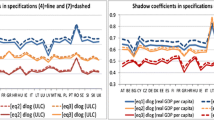Abstract
Using an Endogenous Growth Model with physical and human capital and unemployment (Mauro and Carmeci in J Macroecon 25:123–137, 2003), we study the effects of subsidies to education in economic growth. According to the model, we conclude that government subsidies to education only enhance economic growth conditional on unemployment and that this relationship is negatively influenced by unemployment. We provide evidence from a broad panel data of countries that confirms the importance of unemployment in the relationship between subsidies to education and economic growth but dismiss its importance as a direct determinant of economic growth.
Similar content being viewed by others
References
Aghion P and Howitt P (1994). Growth and unemployment. Rev Econ Stud 61: 447–494
Arellano M and Bond S (1991). Some tests of specification for panel data: Monte Carlo evidence and an application to employment equations. Rev Econ Stud 58: 277–297
Barro R, Lee J (2000) International data on educational attainment: updates and implications. Center for International Development at Harvard University. Working Paper No. 42
Barro R and Sala-i-Martin X (2004). Economic Growth. MIT Press, Cambridge
Blundell R and Bond S (1998). Initial conditions and moment restrictions in dynamic panel data models. J Econom 87(1): 115–143
Blundell R and Bond S (2000). GMM estimation with persistent panel data: an application to production functions. Econom Rev 19(3): 321–340
Bond S, Hoeffler A, Temple J (2001) GMM estimation of empirical growth models. CEPR Discussion Paper No. 3048. London
Dela Croix D and Doepke M (2004). Public versus private education when differential fertility matters. J Dev Econ 73: 607–629
Gómez M (2005) Transitional dynamics in an endogenous growth model with physical capital. human capital and R&D. Studies in Nonlinear Dynamics & Econometrics. http://www.bepress.com/snde/vol9/iss1/art5
Jones C (1995). R&D-based models of endogenous growth. J Polit Econ 103(4): 759–584
Jones C and Williams J (2000). Too much of a good thing? The economics of investment in R&D. J Econ Growth 5: 65–85
Kumar K (2003). Education and technology adoption in a small open economy: theory and evidence. Macroecon Dyn 7: 586–617
Lucas R (1988). On the mechanics of economic development. J Monet Econ 22: 3–42
Mauro L and Carmeci G (2003). Long run growth and investment in education: does unemployment matter. J Macroecon 25: 123–137
Papageourgiou C, Pérez-Sebastián F (2005) Matching up the data on education with economic growth models. Topics in Macroeconomics. The B. E. J. Macroecon. n. 5
Portela M, Alessie R, Teulings C (2006) Measurement Errors in Education and Growth Regressions. CESifo Working-Paper 1677
Rigoline J (2004). Education technologies, wages and technological progress. J Dev Econ 75(1): 55–77
Sahin A (2004) The incentive effects of higher education subsidies on student effort. Federal Reserve Bank of New York. Staff Report No. 192. http://www.ny.frb.org/research/staff_reports/sr192.pdf
Temple J (1999). A positive effect of human capital on growth. Econ Lett 65: 131–134
Yakita A (2004). School loans, subsidies and economic growth. FinanzArchiv Public Finance Anal 60(2): 252–276
Zhang J and Casagrande R (1998). Fertility, growth and the flat-rate taxation for education subsidies. Econ Lett 60: 209–216
Author information
Authors and Affiliations
Corresponding author
Rights and permissions
About this article
Cite this article
Sequeira, T.N., Martins, E.V. Education public financing and economic growth: an endogenous growth model versus evidence. Empir Econ 35, 361–377 (2008). https://doi.org/10.1007/s00181-007-0162-1
Received:
Accepted:
Published:
Issue Date:
DOI: https://doi.org/10.1007/s00181-007-0162-1




